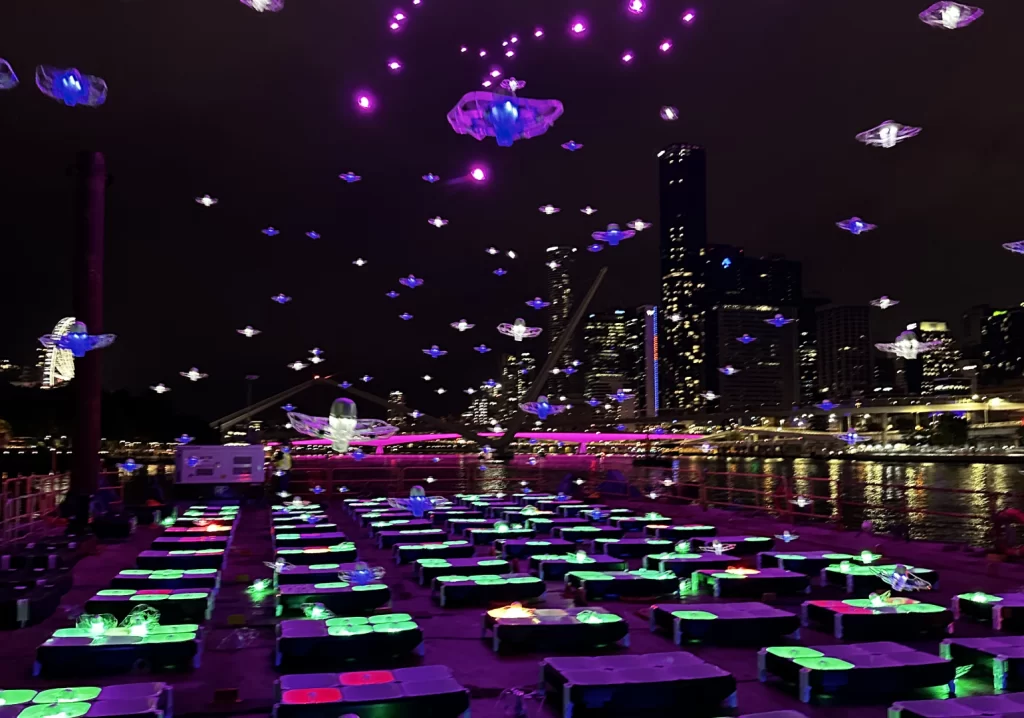The Australian company SkyShows opened BrisFest with a spectacular feat of hardware and software.
Alongside storyteller and Traditional Owner Shannon Ruska, the Australian entertainment technology firm SkyShows launched ‘Nieergoo: Spirit of the Whale’ for the opening night of Brisbane Festival earlier this month.
Telling the Dreaming story of the Yuggera and Turrbal people, the festival-first light show on the Brisbane River brought to life the creation of the local area, known as Meanjin, some 65,000 years ago, with 400 drones lighting up the sky.
Drone shows use swarms of small unmanned aerial vehicles, each equipped with LED lights. The effect looks like hundreds or thousands of pixels in a choreographed set of images in the sky.
“It’s new technology, and people are scared of change,” SkyShows co-founder Andrew Crowe told create. “But Brisbane Festival decided they were going to do something innovative this year, and instead of opening with a large fireworks display, they asked us to help put together a drone launch show.”
[embedyt] https://www.youtube.com/watch?v=2T1c3_jjE7A[/embedyt]
Crowe and his business partner Sue Osborn are former army drone pilots who formed SkyShows in 2020. The company has an enduring lease with Intel Drone Light Shows, which was acquired last year by US-based Nova Sky Stories.
Nova was founded by Kimbal Musk, the less famous brother of Elon, after reportedly being brought to tears by a Burning Man drone light show.
Sparkling technology
Drone light shows came to prominence in July, when hundreds of spoiled drones had to be fished from the Yarra River after a World Cup show went wrong.
Crowe said that SkyShow’s design and software sets their aircraft apart from more conventional drones — and may help forestall such disasters.
“Using technology built by Intel in the United States and software designed in Germany, we fly a Shooting Star version three,” Crowe said.
“From a software perspective, the system is intuitive. The device is a really innovative 340 g drone that can fly in winds of up to 14 m/s or up to nearly 50 km/hr — and even fly in very light rain.”
Most other drone entertainment firms use much heavier drones, which usually weigh two kg or more, and only fly at a pace of around seven or eight m/s, he said.
Letting fly
Crowe said that, while he’d love to have 400 pilots operating the drones, they instead rely on a small staff of pilots on a barge beneath the show as well as a remote command pilot.
“The system allows it to be quite simple, because it runs a lot of checks and balances for us, and won’t let us do anything that we shouldn’t or can’t do,” he said. “For Nieergoo, we had around 450 drones on the barge, and the system conducted optimisation to find the best 400 to fly.”
Optimisation occurs around five minutes before the show begins, measuring things such as battery voltage, GPS and radiolink.
“It will then tell each drone it’s chosen, and what its flight path will be,” he said “There’s 400 different flight patterns for the 400 drones going in the sky. The drones are actually flying blind, they don’t actually know where any other drone is.”
At the end of the show, the drones go through another optimisation process.
“In the blink of an eye during the show, the system says to each device, ‘You’re coming back’,” he said.
Drone swarming
Crowe said that the concept of drone swarming in light shows has a different meaning in a military context.
“There, swarming is more about intragenus or homogeneous swarms making individual decisions within the swarm of those types of teams,” he said.
“I prefer not to call what we do swarming, but there are a lot of mechanics similar to military drone swarming, in that the system will make decisions [and] the human is on the loop but not in the loop.”
Nova’s technology means that Crowe and his colleagues can “interfere with the system” in the event of a problem drone.
“If we can see that an aircraft in the group is having a problem, we have the ability to individually select an aircraft and land it on the deck,” he said.
“It’s the only system in the world that can do that.”
